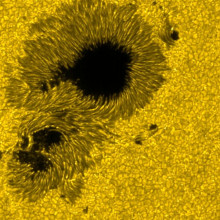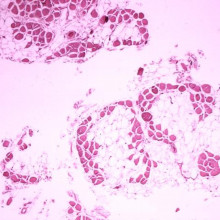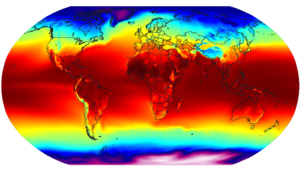We discover diamonds in candle flames in this week's Naked Scientists NewsFlash, but sadly, only a few atoms across! In other news we hear about a new technique for discovering which old drugs will treat existing diseases, how artificial chromosomes may help to treat a type of muscular dystrophy, and why solar seismology can forecast sunspots.
In this episode

00:25 - Predicting Sunspots
Predicting Sunspots
The Sun isn't something you look at very often, with good reason as it is so bright, so we normally think of it as a uniform yellowish disk. But actually it is a very dynamic place with incredibly violent weather.

' alt='Granules-like structure of surface of sun and sunspots.' >Intense magnetic storms well up to the surface of the Sun, forming the slightly darker areas that we call sunspots. These would just be an interesting anomoly if it wasn't for the fact that sunspots can develop into solar flares and ultimately coronal mass ejections, huge explosions on the surface of the Sun which hurl high energy particles out into the solar system. If these hit the Earth they can damage satellites, distort the Earth's magnetic field and generate enough current in power systems to melt transformers.
So that we can be prepared for these events, predicting space weather is extremely important. Up until now this has been based monitoring the visible surface of the Sun, but Stathis Ilonidis and collegues at Stanford University have been studying seismic waves on the surface of the Sun - essentially sunquakes.
For obvious reasons, we can't put seismometers on the Sun's surface. Instead, we use special cameras on board the SOHO spacecraft. These cameras are sensitive to the tiny changes in wavelength of the light coming from the solar surface as it is moved up and down by a seismic wave. From these it is possible to build up a picture of a seismic wave travelling across the surface.
Publishing in Science, the researchers report identifying a distinct series of seismic waves that precede the arrival of a sunspot, and these have their centres at the point where the sunspot erupts on the surface. These waves seem to be created about 40-70,000 km below the surface of the Sun. By studying how these waves are moving they are able to predict a sunspot 1-2 days before it actually appears, which could in the future help give sensitive installations more warning of an incoming solar storm.

03:33 - Gene screen sieves out new treatments for old drugs
Gene screen sieves out new treatments for old drugs
Scientists have developed a technique for finding new ways to treat existing diseases using old drugs.
Writing in Science Translational Medicine, Stanford University researcher Joel Dudley and his colleagues applied the logic that if we know which genes alter their activities in a certain disease, and we can find a drug that has the reverse effect on those same genes, then that drug might well reverse at least some of the symptoms.
Focusing on the inflammatory bowel disease (IBD) ulcerative colitis as a proof of principle, the team mined the database of published gene screens relevant to the condition and also the effects of a range of drugs.
The trawl identified a number of therapeutic "hits" amongst a range of agents that had never even been considered, let alone tried, as treatments for IBD. At the top of the list was an anti-epilepsy drug called topiramate, which scored even better than the current therapeutic gold standard, prednisolone, an immune-suppressing steroid.
To find out whether topiramate is actually be effective at treating the disease, a group of rats with the rodent equivalent of ulcerative colitis were given either prednisolone, topiramate or a placebo. Sure enough, just as the test predicted, topiramate turned out to be as good as prednisolone.
Consequently, say the team, there are likely to be a host of already-approved drugs that could be re-deployed in new directions against existing diseases. So rather than trying to reinvent new ones, they suggest we seek - using tools like theirs - to repurpose the pharmacological wheels we already have in circulation...

07:52 - Artificial Chromosomes for Muscular Dystrophy
Artificial Chromosomes for Muscular Dystrophy
Giulio Cossu, University of Milan
Chris - Duchene Muscular Dystrophy or DMD is a genetic condition in which sufferers lack the ability to produce dystrophin which is an essential structural protein in muscles. This leads to muscle wasting and ultimately, difficulty with walking and breathing, and symptoms usually appear by the age of about 5. Duchene Muscular Dystrophy could be treated by giving patients a healthy copy of that dystrophin gene, but the problem is that the gene is too big to fit into the viruses that we might normally use to add genes to cells. Now researchers in Italy have got around the problem by building an artificial chromosome to carry the gene into some cells and then adding this to stem cells which can then be used to repair damaged muscles. And to tell us more, we're joined by Professor Giulio Cossu from the University of Milan who's the scientist behind this work. Hello, Giulio...
Giulio - Hi.
Chris - First of all, how common is DMD, Duchene Muscular Dystrophy?
Giulio - It is a quite common disease affecting approximately 1 in 3500 males, because the disease is linked to the X chromosome, so that only male children are affected while females are carriers. They can carry the disease, but not be affected themselves.
Chris - And the gene is monumentally big.
Giulio - Yes.
Chris - How big is big?
Giulio - It is actually the largest gene known on this planet. It is larger than many bacterial entire genomes. It's more than 2 million bases which is the main problem for classic gene therapy where the healthy copy of the gene is normally vehiculated through viral vectors, but this gene is too big.
Chris - So, it's not simple to just add a new copy of the gene into the affected muscle cells on account of its size, so what approach have you been taking instead?
Giulio - Well, the approach we took was to use a human artificial chromosome, created in Japan by our collaborator, Mitsu Shimora, who has progressively taken away pieces of chromosome 21 and replace the missing part with the whole dystrophin gene, with all these intervening sequences, regulatory sequences. So it's sort of a mini chromosome that is able to replicate every time the cell replicate its own chromosomes. So it goes around every time that the cell divides and can carry the whole dystrophin gene inside the cells.
Chris - So, you could put that chromosome into a diseased cell that lacks a healthy copy of the dystrophin gene. It would replace the unhealthy gene, make healthy dystrophin protein, and that should make the muscle function improve.
Giulio - That what we found in mice, but as you all know, everything is much easier in mice than in patients! And one reason is that the transfer of the artificial chromosome is inefficient. So that you need to select for the cells that took the chromosome versus all the other many, many more which did not, and human cells do not have, at variance with rodent cells, this infinite ability to proliferate in vitro. Therefore, immediate transfer of this technology to human cells is not possible and will require further technical steps to make it possible. That's what we are working on and we hope to solve this problem in the next years.
Chris - So, given that you can't just add the artificial chromosome directly to the muscle, what approach have you taken instead?
Giulio - So we took this cell that we've been working on for a number of years. They have a terrible name. I apologise this - mesoangioblasts. We weren't able to come out with anything better. Essentially, these are progenitor cells that are associated to the blood vessels, but we've discovered that they're also able to make muscle if taken up from the biopsy of skeletal muscle. The cells can be grown in culture, and in the past we've shown that normal cells can be delivered through the arterial circulation and reach the downstream muscle. That leads to an even distribution of the cells through the downstream muscles and in the past, we were able to show that this transplantation of these donor cell ameliorates the symptoms of muscular dystrophy in dystrophic mice and dogs.
And at the moment, we have a clinical trial running, but the problem is that the strategy with donor cells requires two things - first, the patient need to have an initially identical donor, normally a brother, pretty much like bone marrow transplantation and second, this requires immune suppression which is not a simple thing to do.
Chris - So a better way of doing it would be to take the person's own stem cells, their own mesoangioblasts, and your chromosome to them and then put them back into the patient, and then they'd only be getting their own cells, and that would get around that problem, wouldn't it?
Giulio - Absolutely. The problem now is that we don't have enough cells to do all these things. All these steps can be done with mouse cells but not yet with human cells. So in order for this to be tested on patients, this strategy still requires a few years of laboratory work.
Chris - And when you try to do this on mice, so if you take this mesoangioblast cells from the mouse and you put your artificial chromosome into them, can they improve the function of a mouse with muscular dystrophy and remedy its problem?
Giulio - Yes, that's what we observed. After transplantation of these cells into dystrophic mice, the morphology of the muscles ameliorated. The motility of these animals increased even though it didn't reach the level of a normal mouse. In no case, should we talk about a cure, but just an experimental treatment that in preclinical setting, is producing an amelioration of the symptoms of the disease.
Chris - Thank you very much, Giulio. That's Giulio Cossu from University of Milan. Still work to do, but a wonderful discovery which you can find them out this week in the journal Science Translational Medicine.

Diamonds in Flames
Scientists have discovered diamonds forming in the flames of candles...
The exact compostition of a candle flame is actually very difficult to work out - flames are a dynamic mixture of reacting gasses and get their colour from microscopically small particles of carbon. The problem is that these carbon particles are actively reacting in the flame, and by the time they have left the candle they have reacted to form CO2 or stuck together to form soot. So what exactly is going on in the flame has remained quite obscure.
This point that we don't really know what is going on in a candle flame was made to Wuzong Zhou, Professor of Chemistry at St Andrews University, he took this as a challenge and set about finding out.
The big problem was extracting the particles from the centre of the flame quick enough and stopping the reaction. Zhou developed a new sampling technique which involved using anodic aluminium oxide films - these are a piece of aluminium which has been oxidised electrochemically to form a honeycomb like structure, which contains many holes of controllable size, generally a few 10s of nanometers across. The back of this film can be removed with phosphoric acid leaving, essentially, a filter. He built a sandwich using two layers of filter - the first with 80nm and the second 40nm holes - and put it into a candle flame for about 1 second.
The films were then studied using an electron microscope to identify the products found in a flame. Zhou found tiny pieces of graphite, which you would expect in soot as this is the most stable form of carbon at atmospheric pressure. He also found fullerenes - ball shaped cages of carbon known as "bucky balls". The big surprise was finding tiny diamonds. However, as they are only a few nm across, just a few tens of atoms in diameter, these diamonds are probably not very useful for that engagement ring.
Understanding how these diamonds are nucleating in a flame may be important in understanding the growth of diamonds in the process of chemical vapour deposition, this is used for industrial purposes ranging from scalpel blades to heat sinks and high temperature electronics, but could also be used for jewellery - bringing that engagement ring that little bit closer.

17:20 - Climate change drives animals uphill
Climate change drives animals uphill
Animals overheated by climate change are heading uphill and away from the  equator, a new study has found.
equator, a new study has found.
A range of studies in recent years have suggested that some species are relocating to higher ground and farther from the equator in a bid to remain cool in the face of global temperature rises driven by climate change. But to what extent this migration is comprehensive and global across species was not known.
Now York University scientist Chris Thomas and his colleagues have confirmed, in a paper in Science, that animals really are on the move. The researchers performed a meta-analysis, collating the results of a large number of previous studies that had monitored the movements of over 2000 species, to show that animals are moving uphill at the rate of about 11 metres per decade and shifting their ranges away from the equator an average of 16.9 kilometres over the same period.
These numbers are far larger than those advanced by previous studies. The team cross-checked their results by making predictions of the scale of a species' movements based on the temperature changes in different geographical areas, and then comparing these predictions with the real observations. The two tallied strongly.
There are some exceptions to the rule, with up to 25% of species bucking the general trend, like birds for instance, although accounting for these anomalies is outside the scope of this study. It's also unsurprising since the movement of one species may open up niches or reduce the stress on another species, enabling it to stay put.
The impact of the finding is highly significant and may also have clinical implications for human health as non-native animals move into new terrains, potentially bringing a host of diseases with them...
Related Content
- Previous How do solar sails work?
- Next Do planes trigger rains?









Comments
Add a comment